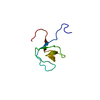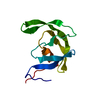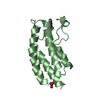[English] 日本語
 Yorodumi
Yorodumi- PDB-2a63: Solution structure of a stably monomeric mutant of lambda Cro pro... -
+ Open data
Open data
- Basic information
Basic information
| Entry | Database: PDB / ID: 2a63 | ||||||
|---|---|---|---|---|---|---|---|
| Title | Solution structure of a stably monomeric mutant of lambda Cro produced by substitutions in the ball-and-socket interface | ||||||
 Components Components | Regulatory protein cro | ||||||
 Keywords Keywords | VIRAL PROTEIN / helix-turn-helix / monomer / ball-and-socket | ||||||
| Function / homology |  Function and homology information Function and homology informationlatency-replication decision / release from viral latency / negative regulation of viral transcription / negative regulation of transcription by competitive promoter binding / core promoter sequence-specific DNA binding / response to UV / protein homodimerization activity / DNA binding Similarity search - Function | ||||||
| Biological species |  Enterobacteria phage lambda (virus) Enterobacteria phage lambda (virus) | ||||||
| Method | SOLUTION NMR / simulated annealing | ||||||
 Authors Authors | Newlove, T. / Atkinson, K.R. / Van Dorn, L.O. / Cordes, M.H. | ||||||
 Citation Citation |  Journal: Biochemistry / Year: 2006 Journal: Biochemistry / Year: 2006Title: A Trade between Similar but Nonequivalent Intrasubunit and Intersubunit Contacts in Cro Dimer Evolution. Authors: Newlove, T. / Atkinson, K.R. / Van Dorn, L.O. / Cordes, M.H. | ||||||
| History |
|
- Structure visualization
Structure visualization
| Structure viewer | Molecule:  Molmil Molmil Jmol/JSmol Jmol/JSmol |
|---|
- Downloads & links
Downloads & links
- Download
Download
| PDBx/mmCIF format |  2a63.cif.gz 2a63.cif.gz | 410.8 KB | Display |  PDBx/mmCIF format PDBx/mmCIF format |
|---|---|---|---|---|
| PDB format |  pdb2a63.ent.gz pdb2a63.ent.gz | 344.3 KB | Display |  PDB format PDB format |
| PDBx/mmJSON format |  2a63.json.gz 2a63.json.gz | Tree view |  PDBx/mmJSON format PDBx/mmJSON format | |
| Others |  Other downloads Other downloads |
-Validation report
| Summary document |  2a63_validation.pdf.gz 2a63_validation.pdf.gz | 345.4 KB | Display |  wwPDB validaton report wwPDB validaton report |
|---|---|---|---|---|
| Full document |  2a63_full_validation.pdf.gz 2a63_full_validation.pdf.gz | 474.7 KB | Display | |
| Data in XML |  2a63_validation.xml.gz 2a63_validation.xml.gz | 21.8 KB | Display | |
| Data in CIF |  2a63_validation.cif.gz 2a63_validation.cif.gz | 35.7 KB | Display | |
| Arichive directory |  https://data.pdbj.org/pub/pdb/validation_reports/a6/2a63 https://data.pdbj.org/pub/pdb/validation_reports/a6/2a63 ftp://data.pdbj.org/pub/pdb/validation_reports/a6/2a63 ftp://data.pdbj.org/pub/pdb/validation_reports/a6/2a63 | HTTPS FTP |
-Related structure data
| Similar structure data |
|---|
- Links
Links
- Assembly
Assembly
| Deposited unit | 
| |||||||||
|---|---|---|---|---|---|---|---|---|---|---|
| 1 |
| |||||||||
| NMR ensembles |
|
- Components
Components
| #1: Protein | Mass: 7423.485 Da / Num. of mol.: 1 / Mutation: A33W, F58D, Y26Q Source method: isolated from a genetically manipulated source Source: (gene. exp.)  Enterobacteria phage lambda (virus) / Genus: Lambda-like viruses / Gene: cro / Plasmid: pET21b / Species (production host): Escherichia coli / Production host: Enterobacteria phage lambda (virus) / Genus: Lambda-like viruses / Gene: cro / Plasmid: pET21b / Species (production host): Escherichia coli / Production host:  |
|---|
-Experimental details
-Experiment
| Experiment | Method: SOLUTION NMR | ||||||||||||||||||||||||||||||||||||||||
|---|---|---|---|---|---|---|---|---|---|---|---|---|---|---|---|---|---|---|---|---|---|---|---|---|---|---|---|---|---|---|---|---|---|---|---|---|---|---|---|---|---|
| NMR experiment |
| ||||||||||||||||||||||||||||||||||||||||
| NMR details | Text: Proton chemical shifts submitted with this deposition were referenced to TSP at 0.00 ppm. However, we should add a cautionary note that this referencing led to an unusually high value for the ...Text: Proton chemical shifts submitted with this deposition were referenced to TSP at 0.00 ppm. However, we should add a cautionary note that this referencing led to an unusually high value for the water signal of 4.966 at 293 K, pH 5.3. We suspect that the TSP resonance is shifted below 0 ppm in our samples, possibly as much as -0.15 ppm. In our view, this is probably due to some transient interaction of the standard with the protein. |
- Sample preparation
Sample preparation
| Details |
| ||||||||||||||||||||
|---|---|---|---|---|---|---|---|---|---|---|---|---|---|---|---|---|---|---|---|---|---|
| Sample conditions |
|
-NMR measurement
| Radiation | Protocol: SINGLE WAVELENGTH / Monochromatic (M) / Laue (L): M |
|---|---|
| Radiation wavelength | Relative weight: 1 |
| NMR spectrometer | Type: Bruker DRX / Manufacturer: Bruker / Model: DRX / Field strength: 600 MHz |
- Processing
Processing
| NMR software |
| ||||||||||||||||||||||||
|---|---|---|---|---|---|---|---|---|---|---|---|---|---|---|---|---|---|---|---|---|---|---|---|---|---|
| Refinement | Method: simulated annealing / Software ordinal: 1 Details: 40 structures were calculated using 838 noe-derived restraints, 14 hydrogen bond distance restraints, 50 phi angle restraints and 17 chi1 angle restraints. All 40 calculations converged to ...Details: 40 structures were calculated using 838 noe-derived restraints, 14 hydrogen bond distance restraints, 50 phi angle restraints and 17 chi1 angle restraints. All 40 calculations converged to structures with no noe violations > 0.5 angstroms and no dihedral angle restraint violations >5 degrees. 14 of the 40 structures were discarded based on incompatibility of the rotamer of val 55 with a small J(HNHB) coupling constant, though no explicit restraint on the chi1 angle was included in the calculation. Of the 26 remaining structures, the 6 with the highest energy were discarded. In addition to having high energies, these 6 structures showed unusual conformations, particularly in turn regions, that were unreasonable and in strong disagreement with previously published structures of lambda Cro variants. The final ensemble contains 20 members. The ordered region of the protein extends from approximately residue 3 to residue 55. Pairwise RMSDs for the ordered region were 0.66 A (backbone atoms) and 1.29 A (all heavy atoms). None of the backbone angles in the ordered region of any ensemble member fell outside the most favorable and additionally allowed regions of a ramachandran plot. | ||||||||||||||||||||||||
| NMR representative | Selection criteria: closest to the average | ||||||||||||||||||||||||
| NMR ensemble | Conformer selection criteria: all structures compatible with experimental restraints; structures chosen had the lowest energies and/or best agreement to J(NHB) data not used in explicit restraints Conformers calculated total number: 40 / Conformers submitted total number: 20 |
 Movie
Movie Controller
Controller










 PDBj
PDBj


 HSQC
HSQC